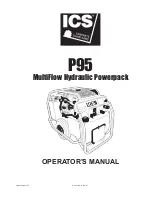
USING THE RPS-1in the OM-420
Omega Engineering Inc.
5
Stamford, CT
voltage is set to 12 VDC or higher output. For 12VDC or higher power supply OUTPUT VOLTAGE
settings, the MAIN POWER SWITCH must be set to 24VDC. In the 12VDC mode, the two batteries are in
parallel, hence the amp hour capacity is doubled (i.e. approx. 4AH). In the 24VDC mode, the two batteries
are connected in series and the amp hour capacity is approximately 2AH
CONTROL INPUT
The two CONTROL INPUT terminals are provided for connection of an external control signal. When
HIGH (5 VDC), any power supplies set to AUTO mode will turn on their outputs. When the control signal
returns to a LO (0 VDC) state, the supply outputs will turn OFF.
Note: Ensure polarity is correct when making control wiring connections.
CHARGING
The two internal gel-cell batteries can be charged from a current source connected to the CHARGER
terminals. Charging can be performed simultaneous with power supply operation. The CHARGER input
will accept an AC or DC source and polarity of connection is not specified as an integral rectifier bridge
circuit compensates for AC or either polarity of DC.
With the MAIN POWER SWITCH set in the 12 VDC position, CHARGER input voltages of 13.5 to 20 VAC
or VDC are acceptable. With the switch in the 24 VDC setting, input voltages of 25.5 to 32 VAC or VDC
are acceptable. Charging current is limited within the RPS-1 to a maximum of 200 mA. Photovoltaic
arrays can be directly connected to the CHARGER terminal allowing for extremely long term stand-alone
operation (contact factory for photovoltaic module and mounting kit information).
NOTE: The MAIN POWER SWITCH must be in the 24VDC or 12VDC position to allow charging.
BOOST CHARGE
The `BOOST CHARGE' momentary push button switch on the RPS-1 provides initial charging current to
units with batteries that have been completely discharged.
If the RPS-1 batteries have been 100% discharged, insufficient voltage exists to enable the charging
circuitry and allow the batteries to recharge. The BOOST CHARGE button bypasses the charging circuitry
and allows a direct charging current to flow into the batteries.
To use the BOOST CHARGE feature on batteries that are suspected as being completely dead (eg no
lights glow when the Battery State of Charge TEST button is depressed) connect up the charging source to
the correct terminals on the RPS-1 as normal. Then press and hold the BOOST CHARGE button for
approximately 10 seconds then release it. To insure that the unit is charging, wait a few minutes, then
press the Battery State of Charge TEST button and one or more lights should glow indicating that the
battery voltage is increasing.
NOTE: Batteries that have been completely discharged may be permanently damaged and will exhibit
shortened life unless they are immediately recharged fully. It is not advisable to discharge batteries to the
point where the BOOST CHARGE is needed to initiate charging.
If the batteries do not recharge after a 24 hour period or discharge very quickly after removal from the
charging source, it is likely that they have been damaged and should be replaced.
STATE-OF-CHARGE (SOC) INDICATION
Depressing the TEST switch connects a slight load across the batteries and displays a relative battery
voltage (indicative of state of charge of the battery) on the 10 step LED display. The test button should be


























